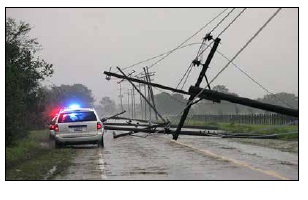Downed Power Lines: Avoiding an Electrical Accident after a Traffic Collision
By Paul Netter

Three accidents, one common denominator and, most importantly, no electrical injuries.
With such fortunate outcomes, why persist about vehicles crashing into power poles and bringing down power lines, right?
While there is no argument that three precarious electrical situations ended without apparent serious injury, there’s also no debating that the vehicle-hit-power-pole accidents in Monterey Park, Santa Fe Springs and Santa Ana provide life-saving lessons in what to do and not do if ever involved in such a situation — as an occupant, bystander or passer-by.
In a recent accident in Monterey Park, Dorothy Hong was trapped in her car for nearly two hours by power lines that had fallen on it from a nearby vehicle-hit-pole accident, according to KABC-TV. Firefighters made sure Hong stayed inside her car, which is always the right move.
In Santa Fe Springs, a savvy bystander, Andrew Rios, guaranteed that right move by yelling and making sure the driver of a truck — who was opening the door to get out — stayed inside until firefighters arrived after the driver had crashed into a power pole and ignited a fire at a recycling plant, KNBC-TV reported.
“The rubber tires can insulate vehicles like Dorothy’s and the truck in such accidents, preventing the electricity from reaching the occupants,” said Andrew S. Martinez, vice president of Safety, Security & Business Resiliency, for Southern California Edison.
Meanwhile, in Santa Ana, Christian Escobar pulled a “confused and dazed” driver to safety after her vehicle crashed into a power pole, KABC-TV reported. Escobar told the station he feared an explosion because of the smell of gas.
“We stress that people wanting to help stay far away, call 911 and help keep others away from any vehicle trapped under or touching power lines,” said Martinez.
It is the same reason firefighters in Monterey Park insisted that Hong stay in her car until SCE could determine if the facilities were de-energized.
“We simply can’t stress enough that for the person inside, the vehicle really is the safest place — unless there’s a fire or some other emergency,” said Martinez. “Exiting your car in any way is still risky, so it should only be done as a last resort.”
SCE offers tips on that emergency car exit along with other dos and don’ts of vehicle-hit-pole accidents:
IF YOU’RE IN A VEHICLE WITH POWER LINES ON IT …
• Stay inside. The ground around your car may be energized.
• Warn any other passengers to stay inside. Even one person exiting incorrectly could put all occupants in danger.
• Sound the horn, crack your window and call out for help or use your cellphone to call 911 (they should advise you to stay in the car as well).
• Warn others to stay away by yelling or honking the horn. Anyone touching the equipment or ground around your car can be injured.
• Wait until the fire department, police or SCE workers tell you it’s safe to exit the vehicle.
IF YOU’RE A BYSTANDER OR PASSER-BY …
• Never approach or touch a vehicle trapped under or touching a power line. Always assume the lines are energized, even if you don’t see sparks.
• Yell to the occupant(s) to stay in the vehicle.
• Call 911 for help.
• Keep other pedestrians and passer-by away.
IF YOU MUST EXIT A VEHICLE WITH POWER LINES AROUND OR ON IT …
• Before opening the door, make sure it is free of anything in contact with the ground.
• Do not step out. Exit away from the power lines, jumping out and landing with both feet together while avoiding contact with both the car and the ground at the same time.
• Do not fall back against the vehicle and avoid any power lines on the ground.
• Then, shuffle, without picking up your feet and keeping your feet close together, a significant distance (at least 50 feet) away from the vehicle.
-----------------------------------------------------------------------------

